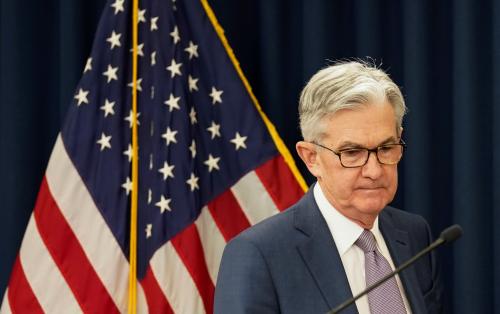This post will be updated throughout the ongoing coronavirus pandemic. It was most recently updated on March 27, 2020.
State and local governments are on the frontlines of this crisis. That means increased spending on public health and Medicaid. As of March 26th, 14 states have enacted supplemental appropriations or transferred general revenue funds in order to help public health agencies deal with the virus, and many others are in the process of doing so. Others will be offering assistance—delays in tax payments or expanded unemployment insurance to affected workers—to cushion the blow on their citizens and residents.
From a public health perspective, ensuring that these agencies have all the funds required to address this crisis is of utmost importance. But economically, the larger source of stress may
be the effects of the coming recession. Large scale “social distancing” will reduce consumer spending and workers’ wages and, in turn, cause sales and income tax revenues to plummet. State tax revenues declined by more than $120 billion—about 9 percent—during the Great Recession (Q2 2008 – Q2 2009), for example.
Increases in unemployment will boost spending on unemployment insurance and make more people eligible for Medicaid, both of which state governments help finance. Lower taxes and increased demands for funding will impose severe strains on state and local budgets.
WILL STATES AND LOCALITIES IMMEDIATELY CUT SPENDING IN ORDER TO BALANCE THEIR BUDGETS?
States have less room than the federal government to increase spending in response to downturns. Most states have balanced budget requirements, meaning that declines in tax revenues, if not offset by increases in federal funding, must be met by spending cuts or tax and fee increases.
Fortunately, these cutbacks may occur somewhat gradually, since it is difficult for state and local governments to make quick adjustments to spending: Contracts for the current fiscal year have already been written, and budget authority has already been granted to agencies. Furthermore, states came into this crisis with record-high rainy day fund reserves. The median rainy day fund balance has more than quadrupled since 2010, reaching 7.6 percent of state general spending by the end of 2019. States will undoubtedly use these funds to help cushion the blow of the pandemic.
But recent developments have increased the short-term pressure on state budgets. Investor worries about the effects of the pandemic have spilled over into the market for municipal bonds, making debt more costly for states and localities—when they can borrow at all—and pushing the Federal Reserve to step in with support. In addition, the Treasury’s recent decision to delay the tax deadline until July 15, while beneficial for taxpayers, may create a cash shortfall for states that follow the Treasury’s deadlines and were expecting to receive large tax payments on April 15.
Furthermore, with most state fiscal years ending June 30, and with most states required to enact budgets that they expect to balance, it is likely that state and local governments will start paring back spending relatively soon. If the crisis lasts longer than they anticipate, and revenues are falling short of targets, some states will be required to make midyear adjustments (38 states) while others (eight states, plus the four that have no balanced-budget requirements) will be able to run deficits for a while.
WHAT DID STATE AND LOCAL GOVERNMENTS DO DURING THE GREAT RECESSION?
Unlike the federal government, states and localities can’t compensate for lower tax revenues with increased borrowing—they must make up for them with some combination of lower spending, higher tax rates, or fees. After tax revenues declined significantly in 2008 and 2009, state and local governments cut spending sharply.
The figure below shows that spending (excluding spending financed by grants from the federal government) declined after state and local tax revenues plummeted. Even after revenues recovered in 2011 and 2012, state and local spending was sluggish for years while governments rebuilt their budgets.
 Note: Figure shows the 4-quarter percent change in current tax receipts (light blue) and spending (dark blue). Spending includes state and local consumption, investment, and transfers to persons net of federal grants to states. Shaded area indicates the Great Recession.
Note: Figure shows the 4-quarter percent change in current tax receipts (light blue) and spending (dark blue). Spending includes state and local consumption, investment, and transfers to persons net of federal grants to states. Shaded area indicates the Great Recession.
Source: Bureau of Economic Analysis.
DO SPENDING REDUCTIONS BY STATE AND LOCAL GOVERNMENTS MATTER FOR THE OVERALL ECONOMY?
Yes. State and local governments are significant players in the U.S economy. Employment by state and local governments, for example, represents about 13 percent of total employment in the U.S., and state and local tax revenues make up about 9 percent of GDP.
According to the Hutchins Center Fiscal Impact Measure, which tracks how much tax and spending policy adds to or subtracts from overall economic growth, cuts in state-financed spending lowered real GDP growth about 1.2 percentage points between 2009 and 2012 (on average, 0.3 percentage point each year).
Automatic declines in taxes that households and businesses paid to state and local governments helped fuel private spending during the recession and boosted growth slightly. Still, the negative effects of spending cuts more than offsets these benefits. The figure below shows the small positive impact on real GDP growth from state and local tax policies (light blue) and the large negative impact on growth from spending cuts (dark blue).
 Note: Bars show the contribution of state and local governments’ spending (excluding that financed by federal grants) and tax policies (light blue) to the growth rate of real GDP beyond its potential, in percentage points. Shaded area indicates the Great Recession. See the Hutchins Center’s Fiscal Impact Measure for more detail.
Note: Bars show the contribution of state and local governments’ spending (excluding that financed by federal grants) and tax policies (light blue) to the growth rate of real GDP beyond its potential, in percentage points. Shaded area indicates the Great Recession. See the Hutchins Center’s Fiscal Impact Measure for more detail.
Source: Authors’ calculations.
WHAT CAN THE FEDERAL GOVERNMENT DO?
Reductions in public spending during a recession are never a good idea, and families suffer when governments cut back on essential services. During the Great Recession, the federal government provided grants to states to help mitigate the cutback. They temporarily increased the federal share of Medicaid spending and provided increased grants for unemployment insurance, education, and infrastructure.
Congress recently enacted the Coronavirus Aid, Relief, and Economic Security (CARES) Act, a $2 trillion relief package that sets aside $150 billion in grants to help state and local governments pay for the costs of the health crisis. In addition, the Families First Coronavirus Response Act, enacted on March 18, raised the federal share of Medicaid by 6.2 percentage points. That increase is worth about $35 billion if it remains in effect all year, but is less than the increase during the Great Recession. The legislation also provided some help to state unemployment insurance programs.
These increases, while helpful, are clearly not nearly large enough to prevent states and localities from having to cut spending. The CARES Act provides only about half as much funding in dollars to state and local governments as was included in the American Recovery and Reinvestment Act of 2009, and states did not face the large increases in public health spending then that they do in the current crisis. Furthermore, Congress said the $150 billion can be used only to cover costs directly related to the coronavirus that weren’t already covered in the state or local governments’ budgets. The funds can’t be used to address increased spending on unemployment insurance or Medicaid or to make up revenue shortfalls, which, even under reasonably optimistic forecasts in which the economy starts recovering in the second half of the year, could be on the order of $100 billion or more. (State and local governments usually earn about $1.1 trillion in sales, excise, and income taxes in a year.)
Federal policymakers should also remember the lessons of the past decade. As shown below, federal grants that financed state and local government spending increased just after the recession and helped boost the economy. But those grants were largely withdrawn by 2011, and overall spending by the sector dragged on growth for several years. This turn to fiscal austerity undoubtedly impeded the economic recovery. Hopefully, policymakers learned that lesson and will ensure that fiscal support is provided quickly and is not withdrawn prematurely.
 Note: Bars show the contribution to real GDP growth from of state and local government spending financed by federal grants (orange) and financed by state and local budgets (navy) in percentage points. Spending includes state and local consumption, investment, and transfers to persons. Shaded area indicates the Great Recession. See the Fiscal Impact Measure for more detail.
Note: Bars show the contribution to real GDP growth from of state and local government spending financed by federal grants (orange) and financed by state and local budgets (navy) in percentage points. Spending includes state and local consumption, investment, and transfers to persons. Shaded area indicates the Great Recession. See the Fiscal Impact Measure for more detail.
Source: Authors’ calculations.
The Brookings Institution is committed to quality, independence, and impact.
We are supported by a diverse array of funders. In line with our values and policies, each Brookings publication represents the sole views of its author(s).









Commentary
How will the coronavirus affect state and local government budgets?
March 23, 2020